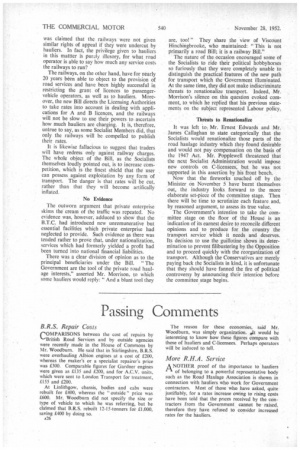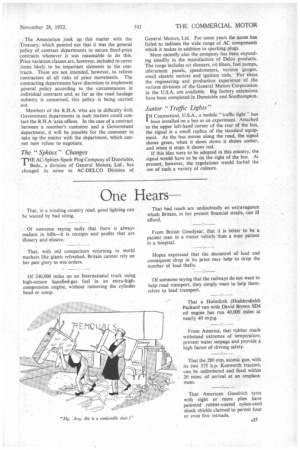Passing Comments
Page 28

Page 29

If you've noticed an error in this article please click here to report it so we can fix it.
B. R.S. Repair Costs
COMPARISONS between the cost of repairs by '-'British Road Services and by outside agencies were recently made in the House of Commons by Mr. Woodburn. He said that in Stirlingshire. B.R.S. were overhauling Albion engines at a cost of £200, whereas the maker's or a specialist repairer's price was £300. Comparable figures for Gardner engines were given as £135 and £200, and for A.C.V. units, which were sent to London Transport for treatment, £155 and £200.
At Linlithgow, chassis, bodies and cabs were rebuilt for £400, whereas the " outside " price was £600. Mr. Woodburn did not specify the size or type of vehicle to which he was referring, but he claimed that B.R.S. rebuilt 12-15-tonners foi£1,000, saving £400 by doing so. The reason for these economies, said Mr. Woodburn, was simply organization. dolt would be interesting to know how these figures compare with those of hauliers and C-licensees. Perhaps operators will be induced to tell,
More R.H.A. Service
AANOTHER proof of the importance to hauliers of belonging to a powerful representative body such as the Road Haulage Association is shown in connection with hauliers who work for Government contractors. Most of those who have asked, quite justifiably, for a rates increase owing to rising costs have been told that the prices received by the contractors from the Government cannot be raised, therefore they have refused to consider increased rates for the hauliers.
The Association ,took up this matter with the Treasury, which pointed out that it was the general policy of contract departments to secure fixed-price contracts whenever it was reasonable to do this. Price variation clauses are, however, included to cover items likely to be important elements in the contracts. These are not intended, however, to relieve contractors of all risks of price movements. The contracting departments have discretion to implement general policy according to the circumstances in individual contracts and, as far as the road haulage industry is concerned, this policy is being carried out.
Members of the R.H.A. who are in difficulty With Government departments in such matters could contact the R.H.A.'area offices. In the case of a contract between a member's customer and a Government department, it will be possible for the customer to take up the matter with the department, which cannot now refuse to negotiate.
The "Sphinx" Changes
JHE AC-Sphinx-Spark Plug Company of Dunstable, Beds., a division of General Motors, Ltd., has changed its name to AC-DELCO Division of General Motors, Ltd. For some years the name has failed to indicate the wide range of AC components which it makes in addition to sparking plugs.
More recently also the company has been expanding steadily in the manufacture of Delco products. The range includes air cleaners, oil filters, fuel pumps, initrument panels, speedometers, various gauges, small electric motors and ignition coils.. For these the engineering and production experience of the various divisions of the General Motors Corporation in the U.S.A. are available. Big factory extensions have been completed in Dunstable and Southampton.
Junior "Traffic Lights"
I N Connecticut, U.S.A., a mobile " traffic light" has been installed on a bus as an experiment. Attached to the upper left-hand corner of the rear of the bus, the signal is a small replica of the standard equipment. As the bus moves along the road, the signal shows green, when it slows down it shows amber, and when it stops it shows red.
If this idea were to be adopted in this country, the signal would have to be on the right of the bus. At present, however, the regulations would forbid the use of such a variety of colours.




















































































